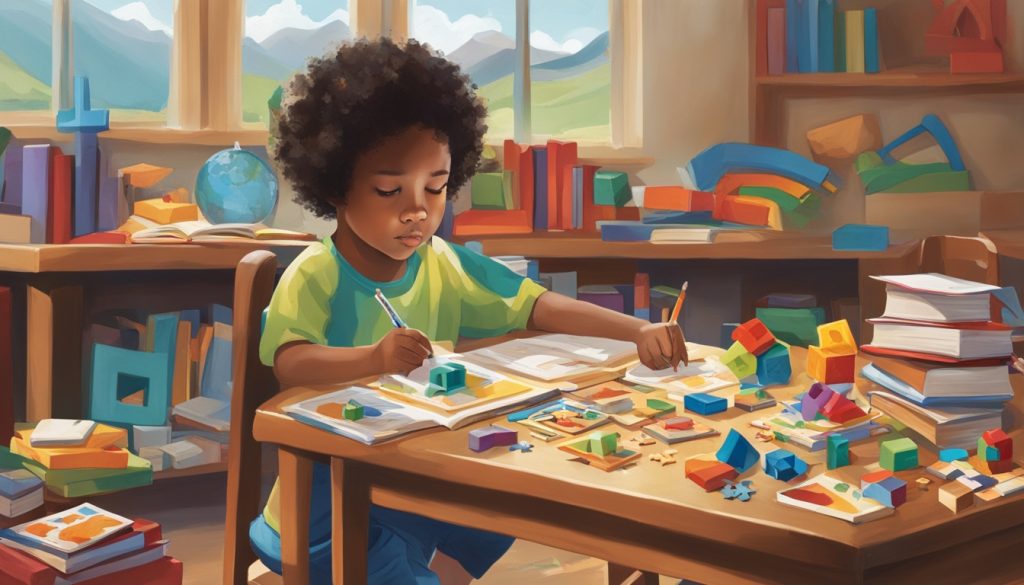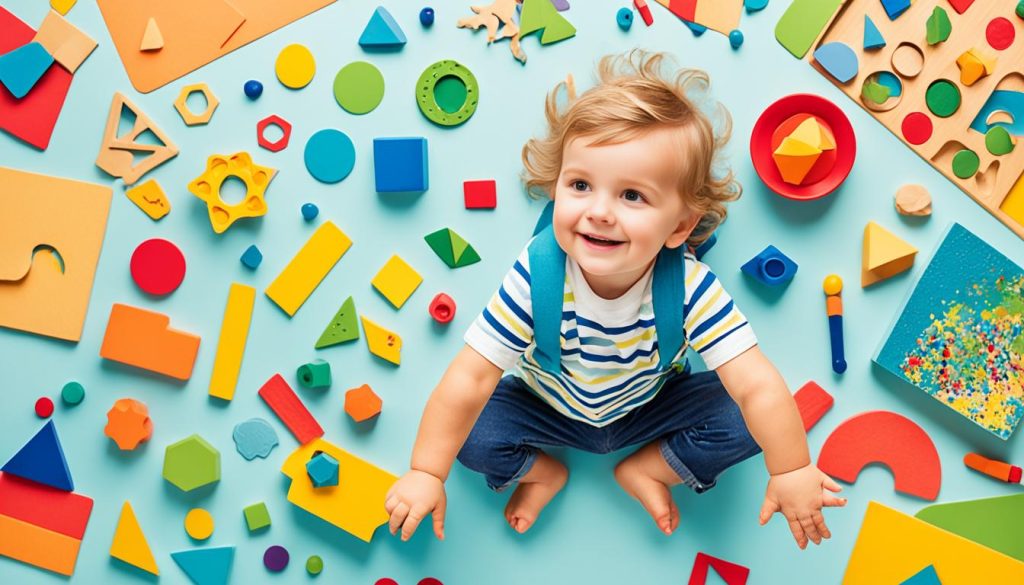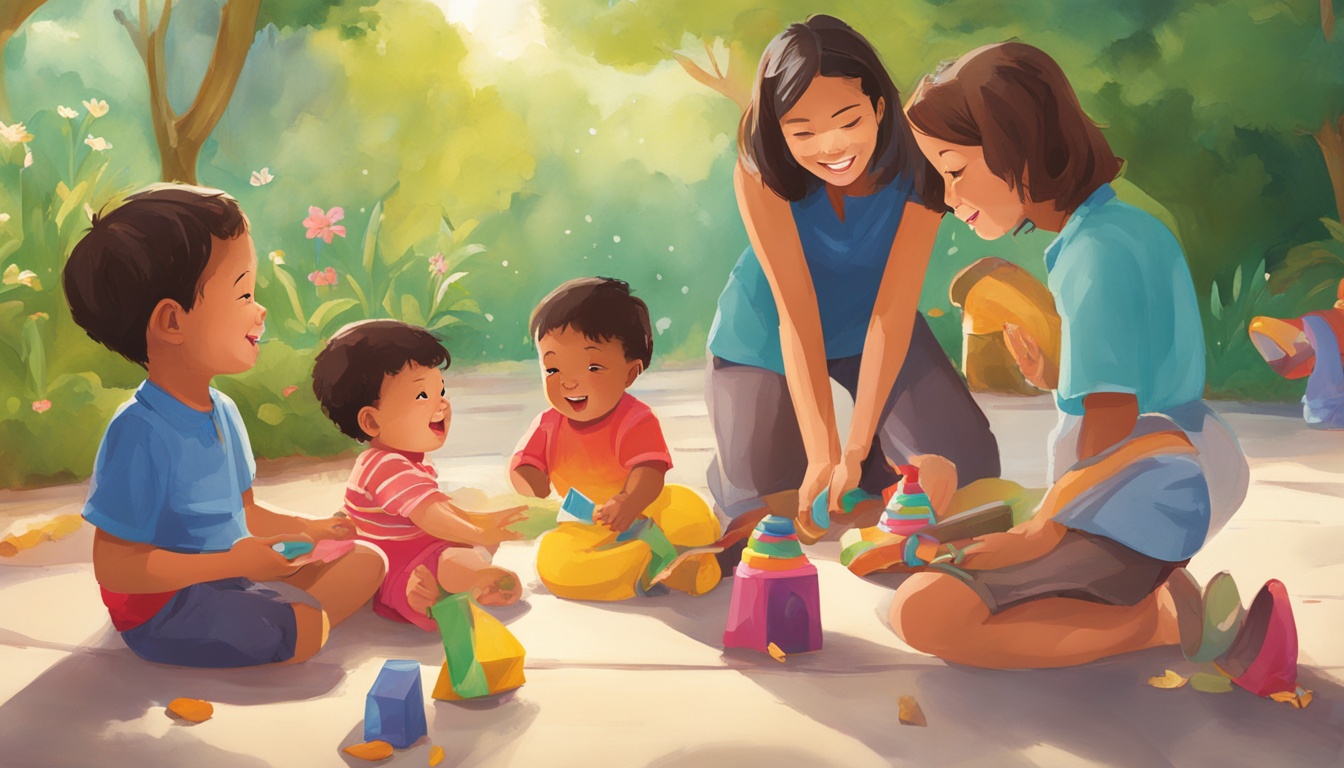Every child is like a budding flower that blooms at its own pace. They have unique petals that need gentle nurturing and understanding. The journey of parenthood shows you that your child is an individual with their own way of seeing and learning.
Recognizing and supporting their unique learning style can change how they see education. It can make them love learning for a lifetime.
Remember the first time you saw your child’s spark of curiosity? Maybe they were listening to a bedtime story or playing with blocks. Each child shows you how they interact with the world. Understanding these signs helps support their learning journey.
Knowing their learning style is not about labeling them. It’s about celebrating their individuality and helping them succeed.
Child development milestones show that kids start to show learning style preferences around age two. These preferences tell us how they take in information. Some kids do well with hearing things, while others like doing things by hand or reading.
Encouraging child creativity means using these learning styles. It helps create activities that fit their natural ways of learning.
This approach makes parenting positive and helps kids feel understood and valued. Schools like Japari School show how personalizing education can help kids succeed in school.
Key Takeaways
- Recognizing your child’s learning style enhances their educational experience.
- Children can exhibit preferences for different learning styles as early as age two.
- Encouraging child creativity involves tailoring activities to their unique learning methods.
- Positive parenting fosters a supportive environment for individual learning styles.
- Personalized education, as seen in institutions like Japari School, can transform learning outcomes.
Introduction to Learning Styles
Knowing how your child learns best is key to their success and happiness. Different learning styles affect how kids take in and use information. They also shape how they interact with the world around them.

What Are Learning Styles?
Learning styles are the ways people like to get, process, and remember information. By knowing these styles, parents and teachers can make learning better and more fun. This method fits well with Positive Reinforcement Parenting by making learning fit the child’s needs.
The Importance of Identifying Your Child’s Learning Style
Finding out your child’s learning style is crucial. It lets you tailor learning to their needs, which can lead to better grades and a love for learning. It also helps in Encouraging Child Hobbies by showing what they’re good at and what they like.
Custom learning plans increase confidence, self-esteem, and motivation. This keeps kids interested and happy with their education.
Identifying Your Child’s Learning Style
Understanding your child’s learning style is key to their growth. Knowing what they prefer can make learning better and boost their self-esteem.
Tips to Help Identify Your Child’s Learning Style
Start by watching how your child reacts to different learning activities and settings. Pay attention to their feelings and actions in various situations.
- Visual Learners: These kids do best with what they see. They like pictures, videos, and seeing things done.
- Auditory Learners: Kids who learn this way get it through hearing. They do well with reading out loud, listening, and talking.
- Kinesthetic Learners: These learners need to touch and move. They like doing things by hand and being active while learning.

Observing Their Preferences and Behaviors
To figure out your child’s learning style, talk to them a lot. Ask what they like and don’t like about learning. Watch what they do every day to see what they prefer.
- Visual: Does your child like watching videos or looking at pictures?
- Auditory: Do they like hearing stories or following verbal instructions?
- Kinesthetic: Are they more into being active or touching things?
Using a mix of senses in learning helps too. It fits with what they naturally prefer and boosts their emotional smarts. The idea is to give them a variety of experiences, like reading, dancing, and building, to use their strengths and work on weaknesses. This leads to better all-around growth.
Every child learns differently, so pay attention to what they like. This makes learning better and more supportive for them.
Visual Learners: Learning Through Sight
Visual learners do best when information is shown to them. About one-third of students are visual learners. They do well with pictures and diagrams. Studies show that matching a child’s learning style boosts their grades. For example, two schools in North Carolina saw big gains in test scores by using this approach.

Characteristics of Visual Learners
- Prefer to see and observe things, including pictures, diagrams, written directions, and maps
- Often remember information in visual forms, such as images and charts
- Excel in reading and learning from visual displays
- Benefit from note-taking and color-coding to differentiate key concepts
Effective Strategies for Teaching Visual Learners
Getting enough sleep is key for visual learners. They need rest to process what they see. Here are some ways to help them:
- Use Visual Aids: Charts, mind maps, flashcards, and educational TV can make learning better.
- Color-Coding: Different colors help keep information clear during notes and improve memory.
- Quiet Environment: A calm, visually interesting place helps with focus and learning.
- Interactive Tools: PowerPoint, videos, and infographics make lessons fun and detailed.
Creating a visually rich environment encourages kids to love learning and remember more. Tailoring lessons to a child’s visual style boosts their creativity and grades.
| Learning Style | Percentage of Students | Effective Strategies |
|---|---|---|
| Visual-Spatial Learners | 30% | Use visual aids, color-coding, quiet environment |
| Auditory-Sequential Learners | 23% | Oral discussions, audiobooks, rhythmic learning |
| Both Hemispheres | 45% | Combine visual and auditory techniques |
These strategies show how important it is to match learning styles. Using visual aids and encouraging creativity can greatly improve learning outcomes.
Auditory Learners: Learning Through Sound
Children who learn best through sound do great when they hear information. They love talking, listening to stories on tape, and being part of a group. Helping auditory learners grow means better talking with your child, supporting their learning, and helping them do well in school.
Characteristics of Auditory Learners
A few kids learn better through sound than others. They’re good at speaking and listening, love to read out loud, and enjoy music. They follow directions well and pay attention to how people sound. But, they might find maps and other visual tasks hard.
Here are some key traits of auditory learners:
- They like talking and reading out loud
- Do well with audiobooks and podcasts
- Have a musical side and make music
- Prefer listening to lectures and directions
- Join in class talks
- Love being social

Effective Strategies for Teaching Auditory Learners
To help auditory learners do well, make learning easy for them. Give them a quiet spot for listening, use audio tools, and get them talking.
Good ways to teach auditory learners include:
- Using songs and rhymes to help remember things
- Listening to audiobooks and educational podcasts
- Getting them to share what they know
- Adding music to their learning
- Letting them talk about what they’ve learned
Parents are key in supporting their auditory learners. Read to your child every day, get them to read out loud, and let them learn through music. Music at home, recording lessons, and knowing they learn by hearing are important.
Building a strong bond with your child through talking and setting rules helps auditory learners a lot. Tailored support and celebrating how they learn can help them grow in school and life.
Teaching kids to be responsible, talking with them, and using their listening skills can make learning complete and effective.
Reading/Writing Learners: Learning Through Words
Reading/writing learners do best with content that uses written words a lot. They are good at reading and writing in school, where most activities involve text. To help them, you can use strategies that play to their strengths.
Characteristics of Reading/Writing Learners
Children who like this way of learning enjoy reading and writing a lot. They can get a lot from:
- Journaling to express thoughts and reflect on daily activities.
- Essay-writing to better organize and convey their understanding of various topics.
- Re-reading notes silently to reinforce comprehension and retention of information.
These activities can make learning a positive experience. They help kids get better at using written words.
Effective Strategies for Teaching Reading/Writing Learners
Using practical methods can really help reading/writing learners do well in school. Some good methods are:
- Encouraging Regular Reading: Make reading a daily habit with your child. Studies show that reading early on helps with language skills and reading later on.
- Engaging in Writing Activities: Give your child lots of writing tools like pencils, crayons, and markers. Encourage them to write stories, notes, or a diary.
- Utilizing Phonemic Awareness Activities: Breaking words into sounds can make reading better. Play language games that focus on sounds and letters.
- Creating a Print-Rich Environment: Keep your child surrounded by different kinds of printed texts. This helps them understand reading better and builds a love for it.
| Strategy | Benefit |
|---|---|
| Daily Reading Routine | Improves language development and literacy skills. |
| Writing Activities | Enhances literacy by merging reading and writing practices. |
| Phonemic Awareness | Aids in becoming a proficient reader through sound recognition. |
| Print-Rich Environment | Promotes understanding of printed text and fosters a love for reading. |
Using these strategies helps teach kids good manners through writing. It also helps them develop healthy habits by making reading and writing a regular part of their life. Creating a supportive space for kids to explore and interact with text helps them grow in school and beyond.
Kinesthetic Learners: Learning Through Movement
Kinesthetic learners use their bodies to learn better. They need special strategies to make the most of their learning. Adding movement to learning helps use their strengths and boosts their success.
Characteristics of Kinesthetic Learners
- They learn by moving their bodies to aid information uptake.
- They benefit from sketching what they are learning.
- They excel in short, intensive teaching moments.
- They are often gifted in sports and have high coordination.
- They require variety to break up long periods of sitting.
- They necessitate frequent breaks for physical activity to maintain attention.
- They often have a strong sense of body awareness but may struggle with subjects like English or history that are less movement-oriented.
- They tend to be easily distracted by their surroundings and grow bored of assignments quickly.
Effective Strategies for Teaching Kinesthetic Learners
To help kinesthetic learners, add physical activities to lessons. They do well with hands-on activities and tasks that involve movement.
- Implementing short breaks with physical activity, such as standing, jumping, or stretching, to foster focus and retention.
- Utilizing manipulatives for subjects like math or science can significantly enhance learning outcomes.
- Incorporating movement-based projects like building labs or practical tasks ensures engagement and improved comprehension.
- Employing tools such as standing desks, fidget toys, peddlers, and yoga balls during class to facilitate movement.
- Encouraging parents to collaborate with educators, reinforcing learning at home through movement-based exercises.
- Participating in programs like MindFinity, which blend educational content with physical activity, can further aid cognitive development.
Adding outdoor play can also help kinesthetic learners. It lets them learn while enjoying nature. Managing screen time helps them focus on physical activities over sitting and playing games. This helps them become independent as they learn through movement.
When teachers and parents understand and meet the needs of kinesthetic learners, these students can do well in school and sports. Using the right strategies leads to a balanced and effective learning experience for them.
The Power of Multisensory Learning
Learning in a way that uses many senses can really help a child’s education. It meets their different learning needs. By mixing visual, hearing, reading, writing, and touching, it helps everyone learn better.
Incorporating Various Learning Styles
Using many senses is key to multisensory learning. Visual methods might use pictures and text. Auditory can be music and rhymes. Tactile might be sand trays, and kinesthetic could be dancing.
This way, every child gets a fair chance to learn and remember. It doesn’t matter what their main way of learning is.
Benefits of a Multisensory Approach
Research shows that learning with many senses is great for kids. It’s especially good for those with ADHD or dyslexia. Using more senses helps kids remember better, focus better, and learn more.
Methods like sand trays or touch-and-spell can even change how the brain works. This makes learning easier for kids.
Adding Family Respect and Empathy makes learning kind and understanding. It’s key for Child Social Skills Development. Teaching kids about money through fun activities makes learning fun and useful.
Overall, multisensory learning helps kids do well in school and in life. It’s great for their minds and hearts.
Parenting and Raising Kids: Supporting Learning at Home
Positive Parenting is key to making a home that helps a child learn and grow. The National Research Council and Institute of Medicine say young kids rely a lot on parents for safety and happiness. This shows how important a good learning space at home is.
Parents help kids become emotionally strong and behave well. This helps kids avoid feeling anxious or depressed. It lets them do well in school and make friends.
Creating a Positive Learning Environment
Having a set but flexible learning area at home helps kids do better in school. A desk in their room or a lap desk can make them focus better. Adding a regular schedule, especially when learning at home, keeps things consistent.
Doing different activities, both online and offline, makes learning fun. This helps kids be creative.
“Providing breaks throughout the day or engaging in outdoor activities such as walks or bike rides can positively impact children’s learning experience.”
To manage screen time, set times when no tech is allowed and keep devices away after learning. This teaches kids discipline and encourages them to be active. Being active helps kids learn better.
Collaborating with Educators
Working with teachers makes learning at home even better. Talking often with teachers helps everyone teach the child the same way. This teamwork makes sure the child learns well at school and at home.
Programs like Raising Caring Kids give parents tools to help their kids be socially and emotionally smart. These programs fit easily into daily life, helping kids grow in all areas. By teaching kids to be socially and emotionally smart, parents help them succeed in school and life. This also helps with getting along with siblings and keeping the home peaceful.
| Key Component | Strategy |
|---|---|
| Learning Station | Desk in a bedroom or a lap desk |
| Balanced Schedule | Structured timings for learning and breaks |
| Screen Time Management | Tech-free times, device storage post-learning |
| Physical Activities | Outdoor activities like walks or bike rides |
| Parental-Teacher Communication | Consistent updates and shared teaching methods |
| Emotional Skills Programs | Resources like Raising Caring Kids |
Conclusion
Understanding how your child learns best is key to their success in school and beyond. Research shows that 26% of parents see the importance of each child’s unique learning style. By finding out what works best for your child, you can help them develop a lifelong love for learning.
This approach not only helps them do well in school but also builds a strong, balanced character. As a parent, you are crucial in figuring out and supporting your child’s learning style. This makes learning more effective and fun.
Many parents, 18%, want to raise kids who are independent and confident. Others, 37%, focus on teaching them moral values and a strong work ethic. By supporting your child’s learning style, you help them become resilient and ready for life’s challenges.
Using different learning styles, like a mix of senses, can greatly benefit your child. 31% of parents believe in giving kids a variety of activities, including sports and fun activities. This approach improves their learning, emotional, and social growth.
Also, teaching kids to be grateful can boost their emotional health, says 29% of parents who value spending quality time with their kids. Creating a supportive and rich environment helps your children become well-rounded, lifelong learners.
FAQ
What are learning styles?
Why is it important to identify your child’s learning style?
How can I identify my child’s learning style?
What are the characteristics of visual learners?
What strategies can help with teaching visual learners?
What are the characteristics of auditory learners?
What strategies are effective for teaching auditory learners?
What are the characteristics of reading/writing learners?
What strategies can help with teaching reading/writing learners?
What are the characteristics of kinesthetic learners?
What strategies are effective for teaching kinesthetic learners?
What is the power of multisensory learning?
How can I create a positive learning environment at home?
How can collaboration with educators enhance my child’s learning?
How does identifying my child’s learning style benefit their overall development?
This post contains affiliate links. If you click on a link and make a purchase, I may earn a small commission — at no extra cost to you. Thank you for supporting this blog and helping me keep the patterns free! Read the full Affiliate Disclosure & Transparency.
